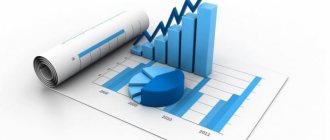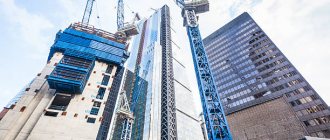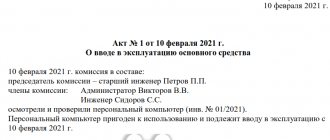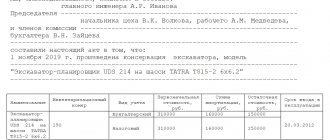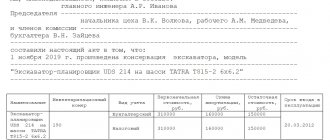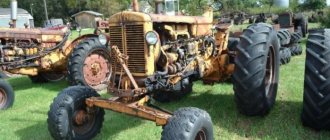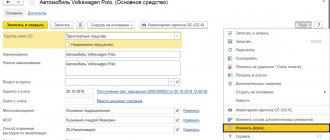The depreciation rate of fixed assets is an analytical indicator used when making management decisions about the reconstruction, modernization or replacement of fixed assets.
The depreciation rate of fixed assets is calculated based on financial reporting data. Usually this indicator is of interest to the owners and heads of departments of the enterprise, but sometimes third parties are also interested in it: creditors, counterparties, investors. The condition of fixed assets is one of the key criteria for assessing the profitability of an enterprise.
Today we will talk about how to calculate the depreciation rate of fixed assets and how to apply the results obtained in the financial analysis of the company's assets.
Definition
Fixed assets include expensive equipment, real estate, vehicles, machinery and other assets, the initial price of which is more than 100,000 rubles.
Any fixed asset is subject to wear and tear, regardless of its use in production and economic activities. Depreciation is accrued in accordance with the object’s belonging to a depreciation group according to the classification approved by government decree. The belonging of property to depreciation groups depends on the useful life of the object, which must be more than 12 months. Inventory and other property with a service life of less than a year are not classified as fixed assets and are written off as expenses in the reporting period in which they were actually used.
The concept of depreciation is not closely related to actual use. Depreciation is a partial transfer of property value to production costs. The degree of activity in the operation of a particular piece of equipment or machinery does not affect the amount of depreciation, and, consequently, the wear rate.
To determine the degree of depreciation of fixed assets, a coefficient is calculated that shows how many percent the property has lost in value. Let me immediately note that this has nothing to do with the market value of the property.
Thus, a building purchased for 1 million rubles, with accrued depreciation of 50% 10 years after its acquisition, can cost 3 million rubles if real estate prices rise. The same applies to cars, machine tools and other equipment.
Reducing the initial cost of an object is a process that depends on the following factors:
- belonging of the property to the depreciation group;
- depreciation method;
- carrying out repairs and modernization.
Example of calculating obsolescence
Depreciation of fixed assets: types, calculation features
Depreciation of fixed assets reflects the gradual loss of their properties. It is important for any organization to correctly calculate and account for all types of wear and tear. In the article, we will consider the types of depreciation of fixed assets and give examples of calculation using the formula and indicators.
Types of depreciation of fixed assets
The loss of value of fixed assets is caused by various factors. Depending on them, there are several types of wear. For ease of perception, they are presented in the table.
| Type of wear | Causing factors | Example |
| Physical | Loss of value is due to physical, biological, chemical and other similar characteristics of fixed assets | Destruction of the rail bed as a result of operation Death of livestock Corrosive destruction of the pipeline |
| Obsolescence of the first kind | The emergence of analogues of fixed assets that cost much less | The cutting equipment uses the latest artificial diamonds, which makes them cheaper |
| Obsolescence of the second kind | The emergence of similar equipment with greater productivity | The matrix printer was replaced by a laser. A manual machine was replaced by a programmable one. |
| Social | Fixed assets are losing their value due to the emergence of safer and more comfortable | Replacing air conditioners with a single ventilation system |
| Ecological | Tightening environmental standards | In aviation, requirements for aircraft are regularly tightened, so they need to be constantly repaired or replaced |
Social and environmental wear and tear are taken into account extremely rarely and only in certain areas. Traditionally, physical as well as obsolescence are measured.
Calculation of physical depreciation of fixed assets
This type of wear and tear manifests itself as a result of changes in various properties of fixed assets, which appear due to their use in the labor process, as well as the impact of natural and other factors on them. In an economic sense, physical wear and tear is a decrease in the original consumer value of fixed assets. It becomes the result of wear and tear, dilapidation and obsolescence. This type of wear can be determined in two ways:
1. Based on the volume of work: a comparison of the actual volume of work performed with the standard is used. This calculation method can only be used in cases where the fixed asset has a certain productivity . In other words, it can be applied to objects such as machines and machine tools. In this case, wear is calculated using the formula:
And = (Tfact x Pfact) / (Tnorm x Pnorm) , where
· Tfact—time actually worked by the equipment (measured in years);
· Pfact – average volume of products produced annually (in physical terms);
· Tnorm – standard service life of a fixed asset (in years);
· Pnorm – production capacity or productivity according to standards (in natural units).
2. According to service life. Determined by comparing the actual and standard operating time. This method is applicable to any fixed asset. In this case, wear is determined by the formula:
And = Tfact / Tnorm
Thus, using the first calculation method is more optimal, since it is based not only on the service life, but also on its intensity.
Example of determining physical wear and tear
The equipment was put into operation on January 1, 2012. The standard service life is 10 years. Production capacity – 600,000 units per year. Calculate the degree of wear and tear as of January 1, 2022, if it is known that on average 620,000 units of products are produced per year.
1. By volume of products: I = (5 x 620,000) / (10 x 600,000) x 100% = 51.7%
2. By service life: I = 5 / 10 x 100% = 50%
Calculation of OS obsolescence
This type of depreciation reflects the loss of efficiency in using a fixed asset until the end of its useful life . There are two types.
Obsolescence of the first type
Obsolescence of the first type manifests itself as a result of a decrease in the cost of fixed assets due to the cheaper prices of their analogues in modern production conditions. In this case, the amount of wear can be calculated using the formula:
And = (Ffirst - Fvost) / Ffirst,
Where:
· Fperv – the initial cost of the fixed asset in rubles;
· Fvost – replacement cost of fixed assets (that is, the costs required to acquire similar assets).
Obsolescence of the second type
This type of wear and tear is associated with the appearance of fixed assets (most often machine tools and other equipment) that have greater productivity or efficiency. Such obsolescence can be complete, partial, or hidden.
· Complete obsolescence is the depreciation of an object of fixed assets, as a result of which the continuation of its operation leads to unprofitable production.
· Partial depreciation involves the loss of part of the value of fixed assets. When it accumulates, the corresponding fixed asset item can be moved to another production operation in which its use will be more efficient.
· Hidden obsolescence is a fairly rare phenomenon. It represents a reduction in the cost of fixed assets due to the approval of an order to create the latest equipment, characterized by greater productivity and efficiency.
When calculating obsolescence of the second type, it is important to assess the feasibility of purchasing new equipment in order to replace the old one.
It can be calculated using the following formula:
И = 1 – (Цс / Цу),
Where:
P – the price of a product on outdated (u) or modern (c) equipment, calculated using the following formula:
C = Ffirst / (P x T)
· P - productivity of outdated (available) equipment;
· Fperv – initial cost;
· T – remaining useful life.
Example of calculating obsolescence
An outdated machine is used in production. Its initial cost is 25 million rubles. The productivity of the machine is 15,000 products per year. The useful life is 15 years. More modern similar equipment has appeared on the market. Its cost is 11 million rubles, annual productivity is 30,000 products. Service life – 12 years.
Let's calculate obsolescence based on the available data:
1. Obsolescence of the first type: I = (25,000,000 – 11,000,000) / 25,000,000 x 100% = 56%
2. Obsolescence of the second type:
· Tsu = 25,000,000 / (15,000 x 15) = 111 rubles
· Tss = 11,000,000 / (30,000 x 12) = 31 rubles
· I = 1 – (31 / 111) = 0.72 or 72%
Depreciation of fixed assets: types, calculation features
Depreciation of fixed assets reflects the gradual loss of their properties. It is important for any organization to correctly calculate and account for all types of wear and tear. In the article, we will consider the types of depreciation of fixed assets and give examples of calculation using the formula and indicators.
Types of depreciation of fixed assets
The loss of value of fixed assets is caused by various factors. Depending on them, there are several types of wear. For ease of perception, they are presented in the table.
| Type of wear | Causing factors | Example |
| Physical | Loss of value is due to physical, biological, chemical and other similar characteristics of fixed assets | Destruction of the rail bed as a result of operation Death of livestock Corrosive destruction of the pipeline |
| Obsolescence of the first kind | The emergence of analogues of fixed assets that cost much less | The cutting equipment uses the latest artificial diamonds, which makes them cheaper |
| Obsolescence of the second kind | The emergence of similar equipment with greater productivity | The matrix printer was replaced by a laser. A manual machine was replaced by a programmable one. |
| Social | Fixed assets are losing their value due to the emergence of safer and more comfortable | Replacing air conditioners with a single ventilation system |
| Ecological | Tightening environmental standards | In aviation, requirements for aircraft are regularly tightened, so they need to be constantly repaired or replaced |
Social and environmental wear and tear are taken into account extremely rarely and only in certain areas. Traditionally, physical as well as obsolescence are measured.
Calculation of physical depreciation of fixed assets
This type of wear and tear manifests itself as a result of changes in various properties of fixed assets, which appear due to their use in the labor process, as well as the impact of natural and other factors on them. In an economic sense, physical wear and tear is a decrease in the original consumer value of fixed assets. It becomes the result of wear and tear, dilapidation and obsolescence. This type of wear can be determined in two ways:
1. Based on the volume of work: a comparison of the actual volume of work performed with the standard is used. This calculation method can only be used in cases where the fixed asset has a certain productivity . In other words, it can be applied to objects such as machines and machine tools. In this case, wear is calculated using the formula:
And = (Tfact x Pfact) / (Tnorm x Pnorm) , where
· Tfact—time actually worked by the equipment (measured in years);
· Pfact – average volume of products produced annually (in physical terms);
· Tnorm – standard service life of a fixed asset (in years);
· Pnorm – production capacity or productivity according to standards (in natural units).
2. According to service life. Determined by comparing the actual and standard operating time. This method is applicable to any fixed asset. In this case, wear is determined by the formula:
And = Tfact / Tnorm
Thus, using the first calculation method is more optimal, since it is based not only on the service life, but also on its intensity.
Example of determining physical wear and tear
The equipment was put into operation on January 1, 2012. The standard service life is 10 years. Production capacity – 600,000 units per year. Calculate the degree of wear and tear as of January 1, 2022, if it is known that on average 620,000 units of products are produced per year.
1. By volume of products: I = (5 x 620,000) / (10 x 600,000) x 100% = 51.7%
2. By service life: I = 5 / 10 x 100% = 50%
Calculation of OS obsolescence
This type of depreciation reflects the loss of efficiency in using a fixed asset until the end of its useful life . There are two types.
Obsolescence of the first type
Obsolescence of the first type manifests itself as a result of a decrease in the cost of fixed assets due to the cheaper prices of their analogues in modern production conditions. In this case, the amount of wear can be calculated using the formula:
And = (Ffirst - Fvost) / Ffirst,
Where:
· Fperv – the initial cost of the fixed asset in rubles;
· Fvost – replacement cost of fixed assets (that is, the costs required to acquire similar assets).
Obsolescence of the second type
This type of wear and tear is associated with the appearance of fixed assets (most often machine tools and other equipment) that have greater productivity or efficiency. Such obsolescence can be complete, partial, or hidden.
· Complete obsolescence is the depreciation of an object of fixed assets, as a result of which the continuation of its operation leads to unprofitable production.
· Partial depreciation involves the loss of part of the value of fixed assets. When it accumulates, the corresponding fixed asset item can be moved to another production operation in which its use will be more efficient.
· Hidden obsolescence is a fairly rare phenomenon. It represents a reduction in the cost of fixed assets due to the approval of an order to create the latest equipment, characterized by greater productivity and efficiency.
When calculating obsolescence of the second type, it is important to assess the feasibility of purchasing new equipment in order to replace the old one.
It can be calculated using the following formula:
И = 1 – (Цс / Цу),
Where:
P – the price of a product on outdated (u) or modern (c) equipment, calculated using the following formula:
C = Ffirst / (P x T)
· P - productivity of outdated (available) equipment;
· Fperv – initial cost;
· T – remaining useful life.
Example of calculating obsolescence
An outdated machine is used in production. Its initial cost is 25 million rubles. The productivity of the machine is 15,000 products per year. The useful life is 15 years. More modern similar equipment has appeared on the market. Its cost is 11 million rubles, annual productivity is 30,000 products. Service life – 12 years.
Let's calculate obsolescence based on the available data:
1. Obsolescence of the first type: I = (25,000,000 – 11,000,000) / 25,000,000 x 100% = 56%
2. Obsolescence of the second type:
· Tsu = 25,000,000 / (15,000 x 15) = 111 rubles
· Tss = 11,000,000 / (30,000 x 12) = 31 rubles
· I = 1 – (31 / 111) = 0.72 or 72%
Conventional wear coefficient
The depreciation rate of fixed assets characterizes only the change in the book value of objects. Actual wear is determined only by checking the technical condition, which is carried out by experts. Why do we need the indicator we are considering?
As has already been mentioned several times, the book value of assets is one of the key indicators of the financial condition of an enterprise. If the wear rate is too high, then there is a chance that the company is not upgrading or updating the equipment. It is known that computer technology quickly becomes obsolete. The same applies to machines and other equipment used in the production process. If a company does not invest money in fixed assets, it means that the owners are either not interested in developing the business, or the company is experiencing a shortage of funds.
Not all interested parties can come to the company with an audit to assess how efficient the equipment is. Therefore, it is important that the data reflected in the reporting does not raise questions among potential investors and partners.
Third parties, as a rule, have only reporting data, where the cost of all objects is reflected in one figure. In order to obtain more objective results, the coefficient should be calculated by groups of assets or separately for each object.
Nonlinear method
Can be used in tax accounting, but not in accounting. Does not apply to objects of 8-10 groups from the classifier, for example, real estate. The cost of fixed assets of one group is summed up, and depreciation is charged immediately to the entire group:
Deductions = Cost of the fixed assets group x Depreciation rate
The brick making machine belongs to the fifth group; the company has only one machine, so the calculation is carried out only for it. The depreciation rate for a brick making machine is 2.7. Depreciation is calculated every month and reduces the cost of the asset every month. In the first year, deductions will amount to 139,982.11 rubles, which is almost twice as much as with the first method. In the month following the moment when the total cost of the fixed assets group becomes less than 20,000 rubles, the company can write it off one-time.
Why is it defined?
In addition to the above, the indicator is used for analytical purposes.
We know that the ratio of asset value to capital significantly affects the degree of competitiveness and investment attractiveness. Thus, the return on assets (ROA) ratio depends on the book value of fixed assets. The coefficients of capital productivity, capital-labor ratio and capital intensity, which you are also familiar with, are also calculated based on the value of assets.
If the book value of an asset decreases, this is a sign that the company is not doing well. Therefore, owners are interested in ensuring that the depreciation rate of fixed assets does not exceed the established values. We will talk about the indicator standards later.
Thus, the coefficient is calculated in order to correctly reflect the data in the financial statements, as well as to determine the potential of investments in fixed assets. Based on the calculations, management and owners make decisions on how much money the company needs to renew its assets and from what sources these funds will be allocated.
As a rule, the indicator is calculated for enterprises in the manufacturing sector, but the price of assets is also important for large trading companies, cargo carriers, and the service sector where equipment is used.
For example, a network of car service centers will lose competitiveness if it uses old lifts. In general, outdated equipment that has not been repaired for a long time poses a threat to both the company’s income and the safety of employees and consumers of the products. The same goes for buildings and vehicles.
Therefore, for any field of activity, the calculation of the wear rate is relevant.
Calculation of depreciation of fixed assets in management accounting
The company compared different calculation methods:
- Linear turned out to be the simplest: write-offs are the same throughout the entire period.
- With the non-linear method, depreciation dragged on for ten years, until the residual value of the fixed assets became less than twenty thousand rubles, in order to write it off one-time.
- The reducing balance method allows you to write off the largest amount in the first year, but every year, in August, the amount of deductions decreases, this needs to be controlled.
- The write-off method based on the sum of years of useful use has the same drawback, but it, the only one of the accelerated ones, allows you to write off the entire amount proportionally during the self-employment period, without a balance in the last month.
- Write-off in proportion to manufactured products allows you to understand what the share of depreciation in the cost price is, but for equipment with a long period of time, it may not be suitable.
As a result, the linear method of calculating depreciation was chosen. The company chooses how to account for depreciation. You can record the accrual on paper, come up with a table in Excel, or use a ready-made solution. In the PlanFact service you can conveniently calculate depreciation. Every month the owner will see exact numbers in the financial reports:
- in the income statement - correct profit;
- on the balance sheet - the residual value of the fixed assets.
The balance sheet, which reflects the receipt of a loan and the purchase of a brick making machine, looks like this:
500,000 rubles (the initial cost of the brick making machine) are reflected in “Fixed assets” and “Long-term liabilities”. After accruing depreciation of 5,200 rubles, the cost of fixed assets in the balance sheet will change:
494,800 rubles is the residual value of the brick making machine. The amount of deductions can be seen in the income statement:
A sinking fund is not an abstract concept, but a special account, preferably with interest on the balance to cover inflation. The company can transfer money into it once a month or allocate a certain percentage of profits from each trade, periodically checking the income statement to control the size of the fund. If equipment requires replacement or repair, you can use money from the sinking fund to avoid taking out a loan.
Formula for calculating the depreciation rate of fixed assets
The classic formula is as follows:
\[ Kizn.=\sum depreciation/PS*100\%, where: \]
\( \sum depreciation. \). – accrued depreciation;
\( PS \) – initial cost.
Calculation of coefficient based on depreciation
So, suppose the machine was purchased for 100 thousand rubles. At the moment, the amount of accrued depreciation is 45 thousand rubles. Let's calculate the wear rate of fixed assets using the formula given above:
Interpretation
There are no standard wear coefficient values. However, a manufacturing enterprise must have its own depreciation rate, which is reflected in internal documents, for example, in an order on accounting policies.
Most companies accept a figure below 50% as the norm. When the total depreciation rate of fixed assets for the organization as a whole becomes 50% or more, it is recommended to make calculations for groups of assets and for individual objects. For fixed assets worn out by 70% or more, a decision is made on reconstruction, modernization or replacement.
Wear coefficient standards
If a certain standard value of an indicator is established for a specific industry, and a different value is recorded in the company’s internal document, then a comparative analysis with competitors, as well as an assessment of investment interest, may give an unreliable picture.
In this regard, it is recommended to adhere to practice-tested values and calculate the depreciation rate of fixed assets by production divisions and asset units.
Wear rate analysis
Here are several criteria that should be followed when assessing and analyzing a wear indicator:
- an increase in the coefficient indicates that the time for modernization or replacement of fixed assets is approaching;
- a value of 50% is considered a “turning point”: after overcoming this mark, it is recommended to make management decisions on the renewal of fixed assets;
- It is recommended to calculate the depreciation coefficient simultaneously with the serviceability coefficient of fixed assets.
Calculation examples
We will calculate the wear and service rates of fixed assets for the enterprise as a whole, by divisions and individual facilities, and analyze the results obtained:
| Division/name of object | Original price | Remainder price | Depreciation | Wear coefficient, % | Usability factor |
| Production workshop No. 1 | 14 444 654,00 | 10 343 952,00 | 4 100 702,00 | 28,39 | 0,72 |
| Four post lift | 1 409 250,00 | 950 310,00 | 458 940,00 | 32,57 | 0,67 |
| Automatic balancing machine | 9 508 848,00 | 5 600 950,00 | 3 907 898,00 | 41,10 | 0,59 |
| Hydraulic machine | 2 530 735,00 | 1 090 222,00 | 1 440 513,00 | 56,92 | 0,43 |
| Refrigeration unit | 995 821,00 | 453 210,00 | 542 611,00 | 54,49 | 0,46 |
| Production workshop No. 2 | 6 931 416,00 | 4 186 058,00 | 2 745 358,00 | 39,61 | 0,60 |
| Electric winch | 2 880 395,00 | 1 435 640,00 | 1 444 755,00 | 50,16 | 0,50 |
| Metal cutting machine | 3 385 641,00 | 2 190 360,00 | 1 195 281,00 | 35,30 | 0,65 |
| Electric stacker | 665 380,00 | 350 650,00 | 314 730,00 | 47,30 | 0,53 |
| Administrative and economic department | 4 023 580,00 | 3 030 490,00 | 993 090,00 | 24,68 | 0,75 |
| Administrative building | 3 690 000,00 | 2 840 000,00 | 850 000,00 | 23,04 | 0,77 |
| Computer | 125 000,00 | 65 000,00 | 60 000,00 | 48,00 | 0,52 |
| Copy machine | 97 320,00 | 40 100,00 | 57 220,00 | 58,80 | 0,41 |
| Air conditioner | 111 260,00 | 85 390,00 | 25 870,00 | 23,25 | 0,77 |
| Total | 25 399 650,00 | 17 560 500,00 | 7 839 150,00 | 30,86 | 0,69 |
So, the overall value for the organization as a whole is far from critical - approximately 31%. Please note that the depreciation and serviceability coefficients of fixed assets add up to 100%:
\[ 31 + 69=100. \]
Nevertheless, it is advisable to modernize some facilities. This applies to the hydraulic machine, refrigeration unit and electric winch.
As for the copier and other office equipment, the issue of replacement is decided on the basis of the equipment’s performance. If the copier is constantly being repaired, the quality of the copies is low, or the equipment is malfunctioning, you may need to think about replacing it.
Reducing balance method
For the calculation, an accelerating factor from 1 to 3 and the residual value of the fixed asset at the beginning of the year are used. "Betonia" chose a maximum acceleration factor of 3.
Deductions = Residual value of fixed assets: SPI in months x Acceleration factor
500,000.00: 96 x 3 = 15,625.00 (rub.) - deductions in the first year of use (from August 2022 to July 2022).
500,000.00 - (15,625.00 x 12) = 312,500.00 (rub.) - residual value as of August 1, 2022.
Each year, contributions will decrease, from August 2022 to July 2023 they will be:
312,500.00: 96 x 3 = 9,766.00 (rub.)
If at the end of the depreciation period there remains an unwritten-off amount, it can be included in deductions for the last month or depreciation can be charged at 582 rubles before the amount is completely written off. Another option is to increase depreciation charges in the last year, paying not 582 rubles monthly, but 1552 (divide 18,626.45 rubles by 12 months).
